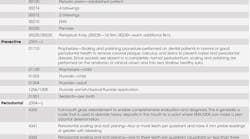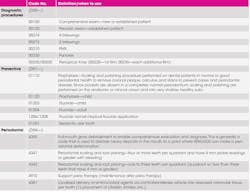BY Jannette Whisenhunt, RDH, BS, MEd, PhD
In this month's column, I will go over some of the insurance coding issues that many new hygienists have very little experience in when they graduate. There are a few things out there that an experienced hygienist does not even think about doing that they didn't learn in school ... things that can be a real challenge for the new hygienist. Most dental hygiene school clinics do not bill insurance companies and do not even take dental insurance. The costs of these school clinics for patients is normally very reasonable, and the need for billing and insurance coding experience is not done when the student is in training. But, when the student graduates, then the insurance and billing procedures come into play very quickly, and new graduates are expected to learn the details very quickly.
A new hygienist has to understand that the codes are critical to how the insurance companies function, and each code indicates a certain procedure. Each procedure, in turn, pays a certain amount to the dentist. There are questions that your new patient may ask you about insurance that you may not be ready to answer. It takes a little studying to get the common questions covered, and there definitely is a large learning curve when you are the new hygienist in your first job.
Click on the chart to view an enlarged image.
D1203 & D1204 codes in the chart above are now considered outdated. Use D1206 or D1208 instead.
To make matters more complicated, insurance companies often change their plans and what they cover or the amount that is covered. It is important for an office to stay up-to-date with the new insurance codes, which sometimes can feel like a full-time job in and of itself. Your insurance person in the office can be a wealth of information and a great resource from whom to learn.
It is very important to be sure that you are coding your procedures correctly for a couple of reasons. First, it is how the office is reimbursed for the services provided. Many people pay out of their pocket for dental services, but the vast majority of regular patients have dental insurance that pays certain amounts for procedures, and the patient pays for what is left over. This causes the office to have to wait for payment in most cases, and if the coding was done incorrectly and has to be redone, then the office must wait that much longer to get paid. This can cause a financial burden for the dental office.
The second main reason that accurate coding is so important is that it is against the law to create a fraudulent claim. If a dentist or hygienist makes a claim that a particular procedure was done but it actually was not, then fraud has been committed. So, it is imperative to make sure you file the appropriate codes for the treatment you actually perform.
My friends from Saving Graceys had some insight for me about insurance coding. Vicky Councilman states, "Once periodontal disease is diagnosed, then we have treatment plan options in place with certain codes attached to them. Now, you would think this is pretty straightforward, but it is not. Insurance companies change their 'criteria' for payment often, and not to mention the Affordable Health Care Act is now putting in its own criteria for payment in the mix."
Vicky Councilman, RDH, of the Saving Graceys website explained a case that had been a challenge in her office. You may have the same issues and realize that you will have to go to bat for your patients' care. The patient is a "young male, 23 years old, has been on a three-month interval because of gingivitis, obvious bleeding on probing, and moderate bleeding on scaling, 4 mm pocketing UR, LR, LL, and new 5 mm UL in molar areas. Crestal lamina dura is now gone.
"So, hygienist and dentist diagnosed four periodontal therapies (combinations of codes D4342 and D4341, depending on number of deeper pockets) with six-week evaluation (total expense around $1,000). All of this was documented. This claim was denied. Why? Because the patient was 23 years old and crestal bone loss is not enough bone loss. Apparently a 23-year-old can't get periodontal disease.
"The doctor and hygienist had to go to bat about this with phone conversations, letters/X-rays, and documentation to get payment. This takes so much valuable time! This is hygiene in the 21st century, yet it seems as though it is a constant puzzle. Our office/insurance manager has an assisting degree and was trained in soft-tissue management 20 years ago with me. She speaks the language very well. But for those offices that aren't so lucky, it will be up to the doctor and hygienist to explain the rationale for their treatment decisions. (Saving Graceys)
When discussing insurance lingo with patients, we need to mention the usual customary reasonable fee or the UCR. This is an average fee of procedures in an area, and most times it is lower than normal office fees. Most major insurance companies pay a certain percentage of the UCR (not the office's normal fee) for most restorative procedures. What is really nice is that most companies pay a much higher percentage, or 100% of preventive procedures. Most insurance companies will only pay for two prophies a year, and they usually have a limited amount or cap amount of what they will cover each year. Sometimes the hygienist is in the position of explaining the patient's insurance coverage and what procedures will be paid for and what may have to be paid for out-of-pocket. When a patient has to come more often than every six months, this is a common explanation to let the patient know that he or she will have to pay for coming more often in order to keep the periodontal disease under control.
For those new hygienists, some advice would be:
• Probe and record every patient. Make sure patients know you are looking for signs of periodontal ("gum") disease.
• Know what the practice philosophy is about diagnosing and treating periodontal disease.
• Know when the doctor refers to a periodontist. We send our patients who have probe readings greater than 6 mm, but some practices go to 8 mm. If you do refer, you will probably not do soft-tissue management in your office. (Saving Graceys)
There are about 20 codes that a hygienist will use most often that are in three categories: diagnostic, preventive, and periodontal procedures. Like anything else, the more you use these, the more comfortable you will be that you are coding things appropriately. The table below is a short version of the codes that are most commonly used. It is important to check the new coding books each year to keep up with any changes in definitions. I hope the following table will be helpful for those new hygienists out there who think it is just too much all at once. You will get there; have confidence and ask for help when you need it! Happy scaling. RDH
References
- Blair C. Coding with Confidence: the 'Go to' Dental Insurance guide. CDT-2014 edition.
- www.practicebooster.com Publisher: Charles Blair & Associates, Inc.
- Finkbeiner. Practice Management for the Dental Team. 7th ed. Mosby; 2013.
- Councilman V, Causey P. Saving Graceys. www.savinggraceys.com
Jannette Whisenhunt, RDH, BS, MEd, PhD, is the Department Chair of Dental Education at Forsyth Technical Community College in Winston-Salem, N.C. Dr. Whisenhunt has taught since 1987 in the dental hygiene and dental assisting curricula. She has a love for students and served as the state student advisor for nine years and has won the student Advisor of the Year award from ADHA in the past. Her teaching interests are in oral cancer, ethics, infection control, emergencies and orofacial anatomy. Dr. Whisenhunt also has a small continuing education business where she provides CE courses for dental practices and local associations. She can be reached at [email protected].






